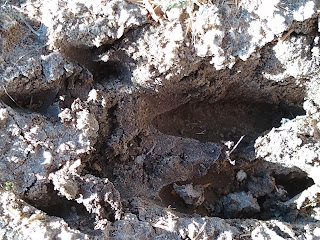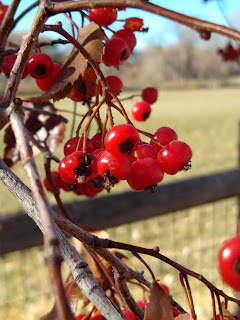Watching things grow and die in the bosque over the years is quite enlightening. But the focus required often means a person could forget that there is a bigger picture here. We are all immersed in a web of life that flows and pulses like the river that directs everything. Whether our own roots are deep, or shallow, we are all connected by nature to each other.
„When one tugs at a single thing in nature, he finds it attached to the rest of the world. “
John Muir
We do not feel the pull of the moon in Corrales quite like they do on the coasts, but we are affected none the less. This picture is the night of the most recent eclipse of the "beaver hunter moon". (I did not stay up for the event). The beavers here do not, of course actually hibernate much at these high temperatures (and low latitudes). Also, they are not hunted much anymore. But they certainly have long memories and are almost never seen by humans during the day.
The small flocks of cranes are still enjoying the large fields. They seem to prefer a wide variety of habitats. They move from bare earth patches, to short grass pastures, to open woodland. They really like being able to see around them. Not surprising in a environment full of cougar, dog-walkers, coyotes, and bob-cats. This time of year they are courting and being very raucous in the middle of the day. The few we have here don't even hint at the multitudes that are down at Bosque del Apache, where the daily fly-out takes an hour to finish. The Canada geese forage on grasses during the day, but they cluster for safety on the Rio Grande river at night. The open spaces, cold mud, and fast water means no predator is going to catch them unawares. The many pairs of eyes means that nothing on the water will be sneaking up without being noticed during the night.
Ducks are hunted by humans all over the US, but it seems like the pressure is far less in this state. Of course, hunting is not permitted in the Bosque Preserve or Corrales. Ducks clearly prefer the protection of ditches instead of the river and show a preference for tight places a large hawk would have trouble navigating in. They like water that is less that six inches deep and still.
All animals have a "preferred" food and a "starvation" food. In the winters crows come together in huge flocks in the bosque. They forage in the local trash dumps for food, but mostly in the winter. This is likely their "starvation" choice because they meet and mate in preparation for the spring and don't have the time to cover vast open areas looking for road-kill; the "preferred" option. They also forage over large areas of open fields next to trees at this time of year. Are they looking for grasshoppers?
The red tailed hawks will hunt a broad variety of prey, but I do not seem them do much of that in the bosque. I suspect they mostly just watch stuff, like I do. They like to perch near the flyways in the trees where the white winged doves funnel through in the mornings, but they only watch. They are one of the few raptors that hunt mammals co-cooperatively. They likely use the bosque to roost, and hunt in the more open areas of the bajada (west side of Loma Larga in the sandy hills)This is a very exciting photograph of a definite javelina (don't pronounce the "j", and not a pig) track. They are in the area for sure and have been seen by quite a few people now. This one is in the base of the clear ditch that will shortly be under water. They are traveling from the Sandia reservation or the Bosque beach to the lush fields of Las Brisas in Corrales at night. They seem to be levering up the flimsy wire fences at the boundary. They are new arrivals to the area from the south and will likely make a big impression when some tangle with people, pets and vehicles. Things will be bad if they find vegetable gardens and apple orchards. Personal advice; they aren't dangerous but give them their space.
Cottonwood plants do not grow as easily as you would think. They seem to need the protection of a nursery ground cover like tall grasses and must be able to tap into the shallow water table. They are very susceptible to fungal attack when older and need lots of space to spread out. Unfortunately, they are not a useful timber species, so there is almost no research into how to grow them. This also means no-one is their champion or protecting their long-term survival in a changing world.
Pyrocantha, or the more colorful gardener's name (marketing name) "firethorn". Not poisonous, but a bird starvation food. Grown because it has thorns and is a great hedge plant. The term "invasive species" has kind of lost it's meaning when just about EVERY plant is imported from somewhere else. Also, we are completely unable to do much about the spread, other than document the loss of native species they replace.
Up on the bajada side there are a few native acacia species (likely Robinia neomexicana) beginning to appear in depressions that hold moisture better than the desert scrubland. This general tree family is an invasive in Hawaii (Molucca albizia), but "behave" better where water is scarce. They stay small, compact and dense. Their deep roots often improve and anchor the soil enough that other plants and animals are able to thrive .
Milkweed thistles also do better where the grass is able to grow to at least ankle or knee height. Come summer they will host a few caterpillar species. They are usually considered a noxious weed because they are poisonous to livestock, but these were found in Rio Rancho city center. No cows here, just parking lots in need of .... pollinators.
In this picture I tried to show how deep the roots of a seedling cottonwood grow. The middle red line is the base of the stem at the soil surface. The roots could be even longer than these as they many not have come out whole. Just below the soil surface, you can see the bushy lateral (surface) roots. In New Mexico, many seedling are using this time to get established and there is often a splash of green under many of the cottonwood leaves along the trails. Something is preventing the cottonwood seedling from establishing. As with most things the answer will end up being more complex than we are willing to deal with right now.











Fascinating. Thanks! I fear for the cottonwoods. We had such glorious fall color from them this year, but ...
ReplyDeleteThe problem is certainly more complicated than it first appears. I have been looking into the growth of cottonwooods in the bosque for a few months. Right now each question just leads to new questions.
ReplyDelete